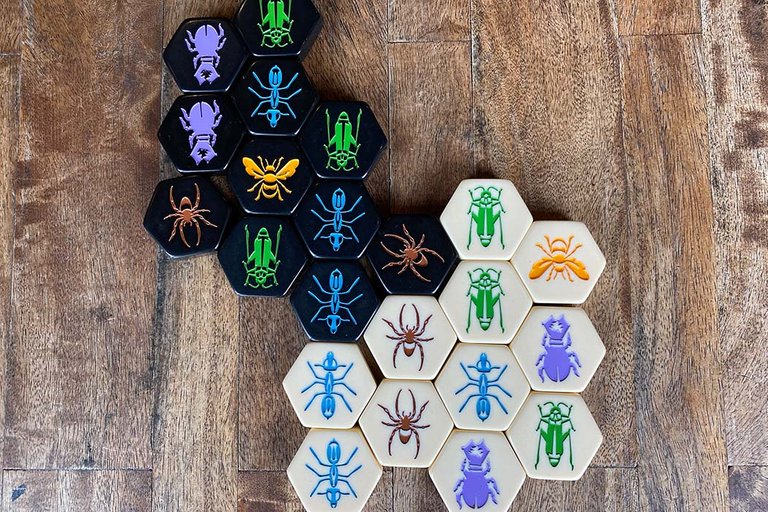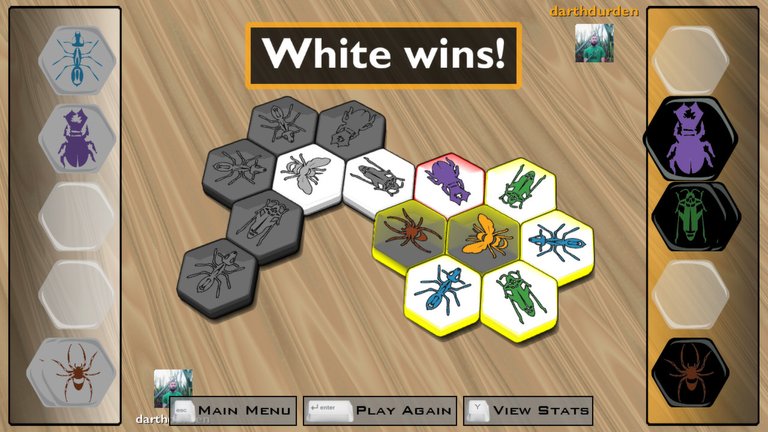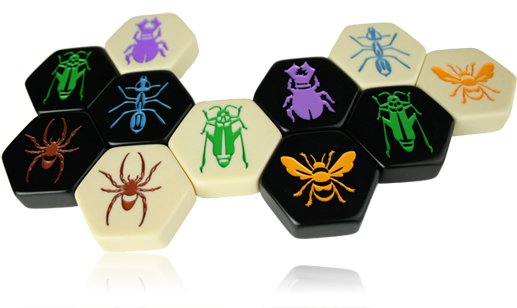Hive Board Game - Tabletop Fantastic Review [ENG/DE]
Sophisticated and simple two-player board game that includes bugs? Absolutely! It's a weird game that really works. Hive is a board game without a board, bear with me, in which a certain number of Bakelite tiles can be placed and played on any surface. This allows for an exceptional game that can be played almost anywhere.
Hive is a game consisting of 22 Bakelite tiles, nothing more. There are 11 black pieces and 11 white pieces - much like chess! The object of the game is to use insect tiles to surround the queen bee on the opposite side.
Each player will take turns placing tiles and moving the pieces on the board - aka any playing surface, even the beach! It sounds really simple, but it has a wonderful deep feel to it.
The artwork on the box is fine, nothing to write home about. But, the inside is a little different. The introduction of the tray containing the game pieces is worth discussing a bit - strange, but noteworthy.
The insert was designed with the hex bits in mind to prevent them from shifting, but more importantly, the insert's shape prevents that pesky crack in the drawer corners. It also allows the spartan theme of the game to shine through. The undistorted design makes it exceptionally beautiful to look at. Even when sitting in the inner staircase.
Versions and expansions
There are some other versions of Hive, based on player preferences. Check out Hive: Pocket for a smaller, more portable version. If you like the classic black/white checkerboard color scheme coil, you should definitely opt for the carbon version.
How to play Hive
Hive is a really laconic game, which is evident in the setting of the game. All that is required for preparation is to remove the tiles from the box. That's it!
Deciding who will go first is up to the players. One option is to keep the chess style and let the white-tiled player continue first. To start the game, each player must place a tile - whichever piece he wishes to use. Next, each turn will then consist of a player who either places a new piece or moves a piece.
This pattern of play continues until one player's bee is completely surrounded. Each insect has a different way in which they can be moved and this complements the role they play in the game.
What separates Hive from Chess, is the fact that no tiles are removed from the game. This allows each player to maintain a relatively strong strength throughout the gameplay.
When placing a new tile, each player must guarantee two things. The first, is that they do not lay the tiles on their own - this is very important. The only time a piece can be placed on its own is when the game is started. Second, tiles placed next to another player tile must be one of the player's tiles, not the opponent's pieces.
The movement of squares in the game is where the magic lies. It is quite obvious that each insect (or spider) has a different way of moving that can affect the final outcome of the game. And one very important rule - a cell can never be divided. The way each tile moves is as follows:
The beetle can only move one tile per turn, and it is able to stack on another tile. It is also possible to stack all four ladybug tiles on top of each other. The general rule is that the color of the ladybug tile on top decides which piece is valid. Ladybug tiles are used to identify other tiles.
Spider tiles can move a total of 3 spaces in a straight line - and that doesn't just mean a straight line! This tile is not allowed to roll back in the same turn.
The grasshopper does what you think it does. It has the ability to jump over other tiles. It helps fill in the necessary gaps.
Ant tile is able to move an unlimited number of tiles. This makes it the backbone of the player's bug fleet. They cannot bypass any other tiles if they are directly in the path of the ants.
The Queen Bee is the most important piece in the game! One can think of her as one of the king in chess. The same way it works - move only one tile and it needs constant protection.

DEUTSCH
Anspruchsvolles und einfaches Zwei-Spieler-Brettspiel mit Fehlern? Unbedingt! Es ist ein seltsames Spiel, das wirklich funktioniert. Hive ist ein Brettspiel ohne Brett, Bear with me, bei dem eine bestimmte Anzahl von Bakelit-Plättchen auf eine beliebige Oberfläche gelegt und gespielt werden kann. Dies ermöglicht ein außergewöhnliches Spiel, das fast überall gespielt werden kann.
Hive ist ein Spiel, das aus 22 Bakelit-Kacheln besteht, mehr nicht. Es gibt 11 schwarze und 11 weiße Figuren - ähnlich wie beim Schach! Ziel des Spiels ist es, die Bienenkönigin auf der gegenüberliegenden Seite mit Insektenplättchen zu umgeben.
Jeder Spieler platziert abwechselnd Kacheln und bewegt die Teile auf dem Brett – auch bekannt als jede Spielfläche, sogar am Strand! Es klingt wirklich einfach, aber es hat ein wunderbar tiefes Gefühl.
Das Artwork auf der Box ist in Ordnung, nichts Besonderes. Aber das Innere ist ein wenig anders. Etwas diskussionswürdig ist die Einführung des Tabletts mit den Spielsteinen - seltsam, aber bemerkenswert.
Der Einsatz wurde mit Blick auf die Sechskant-Bits entwickelt, um zu verhindern, dass sie sich verschieben, aber was noch wichtiger ist, die Form des Einsatzes verhindert diesen lästigen Riss in den Schubladenecken. Es lässt auch das spartanische Thema des Spiels durchscheinen. Das unverzerrte Design macht es außergewöhnlich schön anzusehen. Auch beim Sitzen im Innentreppenhaus.

Versionen und Erweiterungen
Es gibt einige andere Versionen von Hive, basierend auf den Vorlieben der Spieler. Sehen Sie sich Hive: Pocket für eine kleinere, tragbarere Version an. Wer auf die klassische schwarz/weiße Schachbrett-Farbgebung der Spule steht, sollte sich unbedingt für die Carbon-Variante entscheiden.
Wie man Hive spielt
Hive ist ein wirklich lakonisches Spiel, was sich im Setting des Spiels zeigt. Zur Vorbereitung müssen lediglich die Fliesen aus der Schachtel genommen werden. Das ist es!
Die Entscheidung, wer zuerst geht, liegt bei den Spielern. Eine Möglichkeit besteht darin, den Schachstil beizubehalten und den Spieler mit den weißen Kacheln zuerst weitermachen zu lassen. Um das Spiel zu starten, muss jeder Spieler ein Plättchen legen - welches Stück er verwenden möchte. Als nächstes besteht jede Runde aus einem Spieler, der entweder eine neue Figur platziert oder eine Figur bewegt.
Dieses Spielmuster wird fortgesetzt, bis die Biene eines Spielers vollständig umzingelt ist. Jedes Insekt hat eine andere Art und Weise, wie es bewegt werden kann, und dies ergänzt die Rolle, die es im Spiel spielt.
Was Hive von Chess unterscheidet, ist die Tatsache, dass keine Kacheln aus dem Spiel entfernt werden. Dies ermöglicht es jedem Spieler, während des gesamten Spiels eine relativ starke Stärke aufrechtzuerhalten.
Beim Legen eines neuen Plättchens muss jeder Spieler zwei Dinge garantieren. Das erste ist, dass sie die Fliesen nicht selbst verlegen – das ist sehr wichtig. Die einzige Zeit, in der ein Stück alleine platziert werden kann, ist, wenn das Spiel gestartet wird. Zweitens müssen Plättchen, die neben einem Plättchen eines anderen Spielers platziert werden, eines der Plättchen des Spielers sein, nicht die Spielsteine des Gegners.
Die Bewegung der Felder im Spiel ist der Zauber. Es ist ziemlich offensichtlich, dass jedes Insekt (oder jede Spinne) eine andere Art der Bewegung hat, die das Endergebnis des Spiels beeinflussen kann. Und eine sehr wichtige Regel - eine Zelle kann niemals geteilt werden. Die Art und Weise, wie sich jede Kachel bewegt, ist wie folgt:
Der Käfer kann nur ein Plättchen pro Runde bewegen und auf einem anderen Plättchen stapeln. Es ist auch möglich, alle vier Marienkäferplättchen übereinander zu stapeln. Als allgemeine Regel gilt, dass die Farbe des Marienkäferplättchens darüber entscheidet, welches Stück gültig ist. Marienkäferplättchen werden verwendet, um andere Plättchen zu identifizieren.
Spinnenplättchen können sich insgesamt 3 Felder in einer geraden Linie bewegen - und das bedeutet nicht nur eine gerade Linie! Dieses Plättchen darf nicht in derselben Runde zurückgerollt werden.
Die Heuschrecke tut, was du denkst. Es hat die Fähigkeit, über andere Kacheln zu springen. Es hilft, die notwendigen Lücken zu schließen.
Ant Tile kann eine unbegrenzte Anzahl von Tiles verschieben. Dies macht es zum Rückgrat der Bug-Flotte des Spielers. Sie können keine anderen Plättchen umgehen, wenn sie direkt im Weg der Ameisen sind.
Die Bienenkönigin ist die wichtigste Figur im Spiel! Man kann sie sich als einen der Könige im Schach vorstellen. Genauso funktioniert es - bewegen Sie nur eine Kachel und sie braucht ständigen Schutz.

Lustig, manchmal könnte man meinen du redest über unsere Blockchain :)))
Nettes Spiel!
Congratulations @black-eagle! You have completed the following achievement on the Hive blockchain and have been rewarded with new badge(s):
Your next target is to reach 50 replies.
You can view your badges on your board and compare yourself to others in the Ranking
If you no longer want to receive notifications, reply to this comment with the word
STOPCheck out the last post from @hivebuzz:
Support the HiveBuzz project. Vote for our proposal!